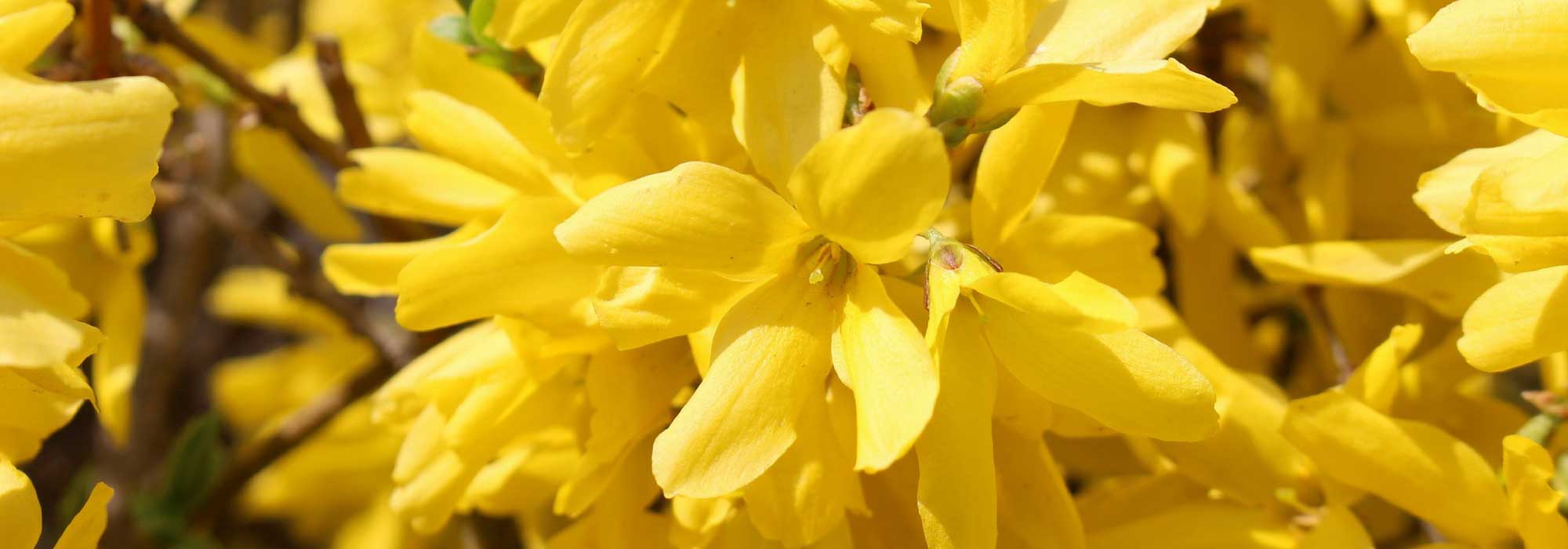
Forsythia : plant, prune and maintain
Contents
Forsythia in a nutshell
- Forsythia is one of the first bushes to flower in late winter
- It offers a generous golden yellow flowering
- It thrives in all types of soil
- Compact and hardy, it is suitable for all gardens
- It can be planted in free hedges, in groups, in flower beds, and also in pots
A word from our expert
The Forsythia, also known as the Paris Mimosa, heralds the arrival of spring, from March onwards, and undoubtedly brightens up a dull hedge or border. This sunny bush is valued for its generous golden yellow flowering that leaves little room for leaves, among the first to illuminate the garden after the long winter slumber.
Today, there are numerous cultivars and hybrids, including the essential Forsythia x intermedia, which comes in many varieties such as Forsythia ‘Marée d’Or’.
Although it is sometimes confused with Abeliophyllum distichum and its cultivar ‘Roseum’, or Korean red forsythia, the forsythia remains, despite hybridization, a bush with yellow flowers. The foliage of forsythia, generally deciduous, can be as spectacular as the flowering in certain species, with leaves variegated in yellow, green, or cream. Its upright and graceful silhouette and moderate size allow for numerous uses in all gardens, from the most naturalistic to the wildest, even the most modest.
Whether planted as a solitary specimen, in a flowering hedge, free or trimmed, as ground cover in a rockery, in a pot, or in a border, this very hardy bush down to -20°C will reveal its splendour as soon as the beautiful season returns. Graphical and dazzling, its bare branches dotted with small yellow flowers are also appreciated for making bouquets as soon as winter is over.
Accommodating and very easy to grow, it thrives in full sun or partial shade and grows anywhere in well-drained soil. Robust, original, space-saving, and very tolerant, discover our forsythias and adopt this essential bush for spring scenes without delay!
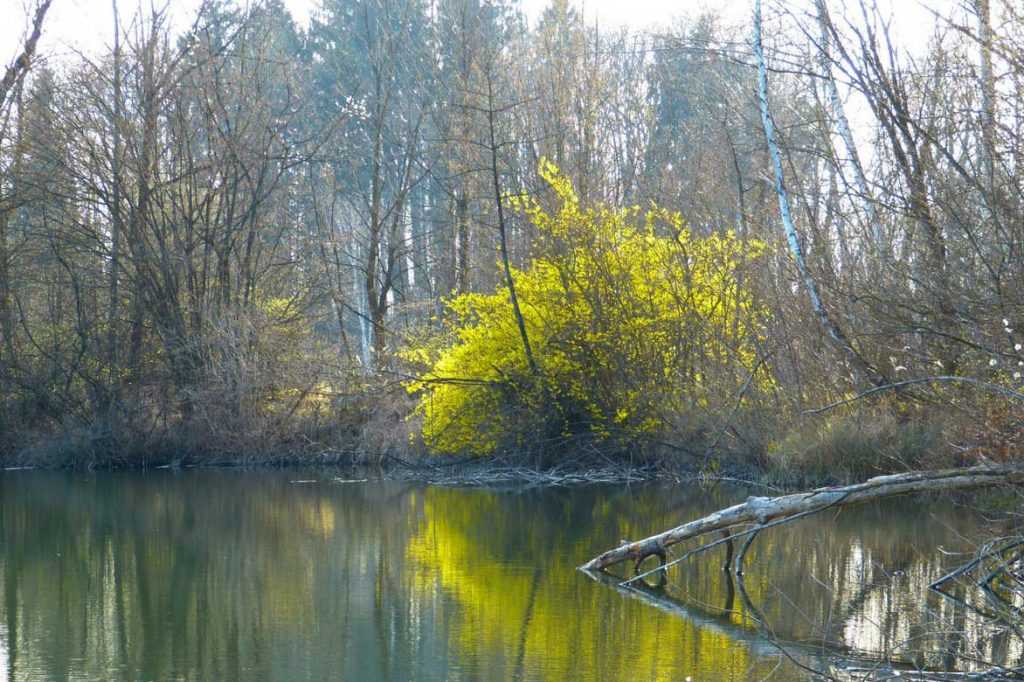
Sometimes considered mundane by some gardeners, forsythia offers a remarkable early flowering.
Description and Botany
Botanical data
- Latin name Forsythia
- Family Oleaceae
- Common name Forsythia, Paris Mimosa
- Flowering From February to May
- Height From 0.45 m to 5 m
- Exposure Sun, partial shade
- Soil type All, well-drained
- Hardiness -15°C to -20°C
Appartenant à la famille des Oléacées, comme le jasmin et le lilas, the Forsythia est a charming deciduous bush, sometimes semi-evergreen, native to Asia, Japan, and China.
The genus Forsythia comprises 7 species and, while not all are cultivated, there are many numerous cultivars and hybrids including Forsythia x intermedia, also known as the Paris Mimosa, an essential hybrid resulting from the cross-breeding of Forsythia suspensa and Forsythia viridissima, which comes in many diverse varieties.
Forsythia has a bushy, dense habit with numerous branches that are often a reddish-brown, highly ramified and erect, tending to spread with age. Initially, its growth habit was rather upright, but due to extensive hybridization, it varies greatly from one species to another, ranging from erect shrubs to compact, rounded forms, arching, or even creeping ground cover like Forsythia (x) intermedia Marée d’or courtasol. The Forsythia koreana ‘Kumsun’ differs from other forsythias by its slightly more spreading habit, while F. (x) intermedia ‘Spectabilis’ has a rather untidy appearance. The Forsythia Mêlée d’Or ® is a recent and original hybrid variety that features a geometrically arranged foliage around the branches, giving it a very geometric look.
Forsythia is characterised by a generally rapid growth.
This bush is divided between bushy species and varieties with a creeping growth habit. Its height varies from only 50 cm for creeping species or dwarf varieties to a large shrub of about 3 m in height in all directions, or even more for the tallest. Ground cover species tend to root naturally, which will provide a beautiful ground cover at maturity.

Forsythia viridissima – Botanical illustration
Forsythia has a early flowering, among the first in spring. Its flowers are remarkable especially because they appear on the wood of the previous year, before the leaves emerge as winter ends when the garden is still bare. From February to March and until May for the later varieties, a profusion of small bell-shaped flowers in bright golden yellow or sulphur yellow, gathered in numerous clusters, adorn the bare stems. Composed of 4 petals and measuring 1 to 4 cm, they literally cover the bare branches. This often very abundant flowering is, however, relatively short-lived.
In a vase, cut branches covered with flowers still in bud create fresh and vibrant bouquets, synonymous with the return of fine weather.
Once flowering is over, the deciduous foliage, most often or semi-evergreen, takes over in the garden. In some species, it is as attractive as the flowers.
Long leaves measuring 4 to 15 cm long, opposite, simple, sometimes very dentate or entire, sometimes trifoliate, are mostly a magnificent spring green. Today, there are many varieties with remarkable variegated foliage, light green edged with yellow in Forsythia ‘Golden Times’, soft green variegated with cream and yellow with a granulated appearance, in Korean Forsythia ‘Kumsun’, distinctly edged with lemon yellow and then cream-white in ‘Citrus Swizzle’. Often, the foliage takes on beautiful reddish-purple hues in autumn.
Cultivating this perfectly hardy and very easy-to-maintain bush is quite simple. It grows in all well-drained soils and under all climates; it even requires a good dose of negative temperatures to encourage the development of its flower buds. It prefers sun but tolerates light shade, where it tends to be less floriferous.
Forsythia finds its place in all gardens, whether large or small. It can be grown in a free and flowering hedge with other spring-flowering shrubs, in a bed or as a specimen. It can even be trained against a wall.
Smaller or ground cover varieties are perfect for low hedges, rockeries, border beds as well as in pots.
Main species and varieties
The genus Forsythia comprises 7 species, but only a few species are very commonly grown in our gardens. The hybrid Forsythia x intermedia is particularly prevalent in commerce, available in many interesting varieties. They are distinguished by their size at ripeness (ranging from 50 cm to about 4 m), their habit (upright or creeping), which determines their use, and their foliage, remarkably variegated in some varieties (‘Golden Times’): in isolation or trained against a wall, in trimmed or free hedges, in low hedges or banks, and finally in containers or pots on a terrace for dwarf or ground cover varieties such as Forsythia x intermedia ‘Marée d’Or’.
Alongside these common species, we offer a range of Forsythias, some of which are exclusive or less widespread, such as the Korean Forsythia ‘Kumsun’ or Forsythia viridissima ‘Citrus Swizzle’, or even supplied as bare roots like Forsythia intermedia.
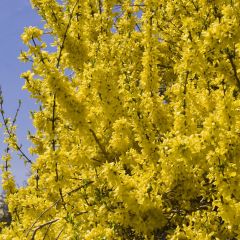
Forsythia intermedia Minigold
- Flowering time April, May
- Height at maturity 1 m
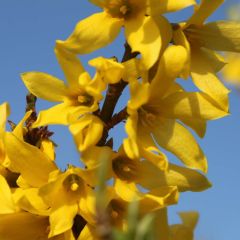
Forsythia intermedia Marée dOr
- Flowering time March to May
- Height at maturity 75 cm
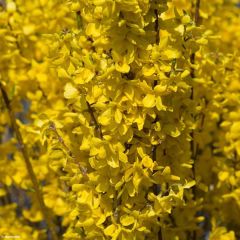
Forsythia intermedia Week-End
- Flowering time April, May
- Height at maturity 2,50 m

Forsythia intermedia Golden Times
- Flowering time April, May
- Height at maturity 1,50 m
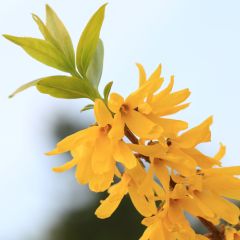
Forsythia viridissima Citrus Swizzle
- Flowering time April, May
- Height at maturity 1 m
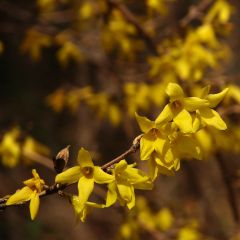
Forsythia koreana Kumsun
- Flowering time April to June
- Height at maturity 1,20 m
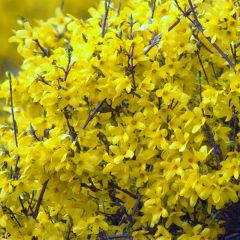
Forsythia intermedia Mêlée dOr
- Flowering time April
- Height at maturity 1 m
Discover other Forsythia
View all →Available in 3 sizes
Available in 3 sizes
Available in 2 sizes
Available in 1 sizes
Available in 3 sizes
Available in 1 sizes
Available in 1 sizes
Available in 1 sizes
Available in 3 sizes
Available in 2 sizes
How to plant a forsythia?
Where to plant a Forsythia?
The Forsythia can be planted anywhere in France, except in Mediterranean climates, which are a bit too hot and dry in summer. With good hardiness, it is capable of withstanding very low temperatures down to -15° to -20°C, ensuring perfect hardiness in all regions. It needs negative temperatures in winter to bloom well in spring.
The Forsythia is preferably planted in full sun where it flowers better, although it can tolerate partial shade. Too dense shade would result in a somewhat less showy flowering.
Not very demanding, it is content with any soil as long as it is well-drained because it fears winter moisture. However, it appreciates a fairly humus-bearing soil that remains cool in summer.
In perennial borders or among spring-flowering shrubs, planted alone, in a flowering hedge or in a pot on the terrace, the Forsythia is not cumbersome and adapts to all gardens. Creeping varieties make excellent ground cover on a slope, as well as low hedges or border plantings. It can also be planted in groups of 3 or 5, under large deciduous trees.
When to plant Forsythia
Planting is preferably done in autumn in September-October or reasonably in spring, in March-April or May, avoiding periods of severe frost to encourage rooting before winter.
How to plant
In open ground
It prefers well-draining soils where water will not stagnate, especially in winter.
In hedges, depending on the varieties, space the plants about 0.60 to 1.50 m apart.
- Soak the root ball in a basin of water
- Remove stones, roots, and weeds from the soil
- Loosen the soil well and dig a hole 30 cm in diameter and 40 cm deep
- Add a good layer of pumice, river sand, or gravel at the bottom of the hole
- Enrich half the soil with potting soil and well-matured compost
- Plant the bush at collar level in the centre of the hole
- Backfill the hole while keeping the bush upright
- Firm the soil around the base of the plant
- Mulch to keep the base clean and cool during summer
- Water generously at planting, then once or twice every 2 weeks during growth in the first year after planting
In a pot
Choose varieties with a rather compact habit and moderate growth such as F. x intermedia ‘Mélée d’Or’. The substrate must be very draining to avoid stagnant moisture at the roots. Repot every 2 or 3 years.
- At the bottom of a container at least 50 cm in diameter, spread a good layer of drainage (gravel or clay balls)
- Plant in good potting soil for shrubs mixed with compost
- Mulch the base
- In summer, water well during flowering and whenever the soil is dry
→ Learn more about growing Forsythia in pots with Christine’s advice
When and how to prune forsythia? What maintenance is required?
The Forsythia requires little maintenance: a good mulch and light pruning. Although it is content with fairly poor soil, adding compost or organic fertiliser in spring improves its growth and encourages its flowering.
While the Forsythia easily adapts to all types of soil, it prefers cool, not too dry soils. In summer, water once or twice a week during hot spells. To keep the base cool during the warm season, apply a good layer of mulch before spring, especially in the first few years after planting.
Pruning is not necessary, except to rebalance the shape that develops with age. This should be done after flowering. In the first three years, a simple refresh of dead, thin, or tangled stems is sufficient. This pruning is not necessary every year.
After that, prune only every two or three years and always after flowering, ensuring good air circulation in the centre of the branches. Cut back the spent shoots by trimming at the base above a large bud.
For a plant older than three years, remove half or two-thirds of the height of dead, thin, or poorly placed shoots to encourage the formation of young stems and rejuvenate the bush. It can withstand even severe pruning down to the ground if you wish to reduce its spread or reshape it.
Diseases and potential pests
The Forsythia is generally very resistant to diseases and pests when planted in good conditions. In poorly drained soil, it can be susceptible to fungal diseases such as:
- Armillaria (or root rot), a fungus that resides beneath the bark and is responsible for root decay, which then spreads to the aerial parts of the bush, leading to its death. There is no remedy, so the plant must be burned; therefore, be sure to avoid excess water in the soil during planting.
- Forsythia gall, which causes swellings on the lower stems. This is not harmful to the bush. As a preventive measure, at the beginning of winter and early spring, spray with Bordeaux mixture. In case of infestation, remove the affected branches.
Multiplication: the cutting
Forsythia propagates easily by herbaceous cuttings in May-June or semi-woody cuttings in August-September.
By herbaceous cuttings
- In spring, take non-flowering stem pieces of 10 to 15 cm long just below a node
- Remove the lower leaves and keep only two pairs of upper leaves. Plant them in a light and well-draining mix of coarse sand and potting soil
- Maintain in a humid and warm environment between 18° and 24°C
- Keep the substrate moist until rooting, which takes 1 to 3 months
- Transplant the cuttings into the ground the following autumn and water well during the first year
By semi-woody cuttings
- At the end of summer, take the thin tip of a semi-hardwood shoot of the year, about 10 to 15 cm long, just below an eye (i.e. in the phase of transition from softwood to hardwood)
- Make a longitudinal cut in the bark for 5 cm
- Remove the leaves from the lower third
- Plant them about 7 cm deep in a well-draining mix of sand and potting soil
- Keep the substrate moist until rooting under a cold frame
- Transplant your cuttings into pots the following spring or plant them permanently
- Water well during the first year after planting
→ Learn more about propagating Forsythia in our tutorial!
Pairing Forsythia
Particularly appreciated for the brilliant explosion of yellow it offers in spring, Forsythia thrives in all natural and wild gardens. King of spring scenes, it pairs well with a multitude of plants that will need to compete with its brilliance and shape.
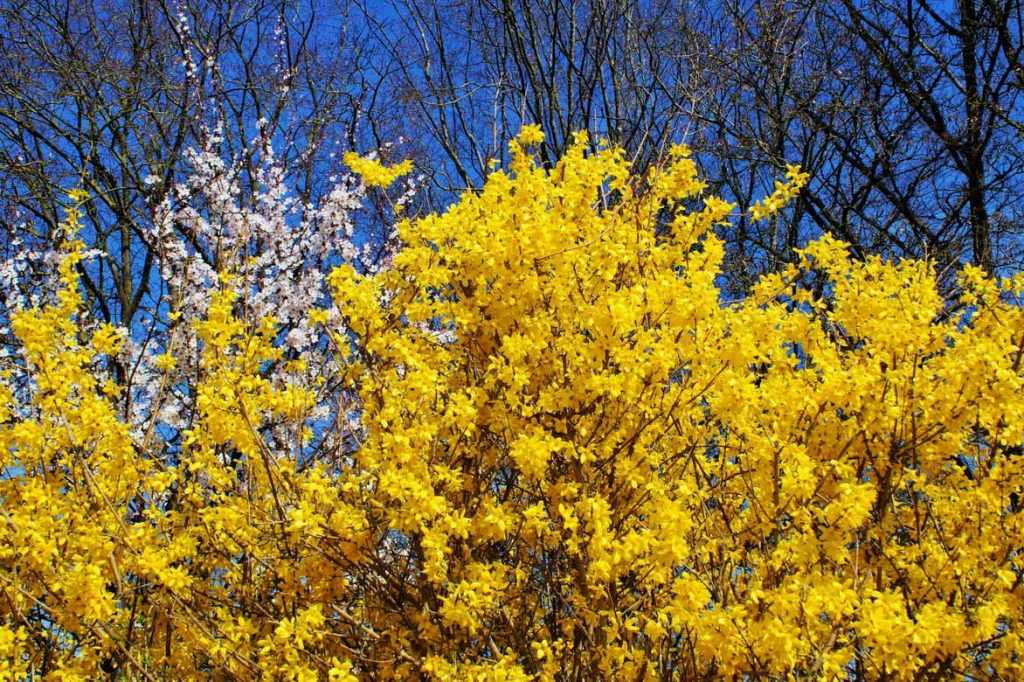
In a free hedge, forsythia pairs with a large number of bushes
In a free and flowering hedge, it will be the ideal companion to spring-flowering bushes such as flowering currants, or alongside Japanese quinces, spiraea, deutzia, Japanese cornels, weigela, and lilacs.
Planted in groups in borders, particularly with its close cousin Abeliophyllum roseum, Abelia grandiflora, the Smoke Tree Cotinus coggygria ‘Golden Spirit’, or the Lilac, it will bring a vibrant touch to the still bare garden. Its bare branches, adorned with a profusion of small golden-yellow flowers, will serve as a backdrop for early-flowering euphorbias, early bulbs such as white and pale yellow daffodils, blue hyacinths, or tulips, and will stand out powerfully in gold/white or gold/blue compositions. It presents a lovely contrast against the blue flowers of forget-me-nots.
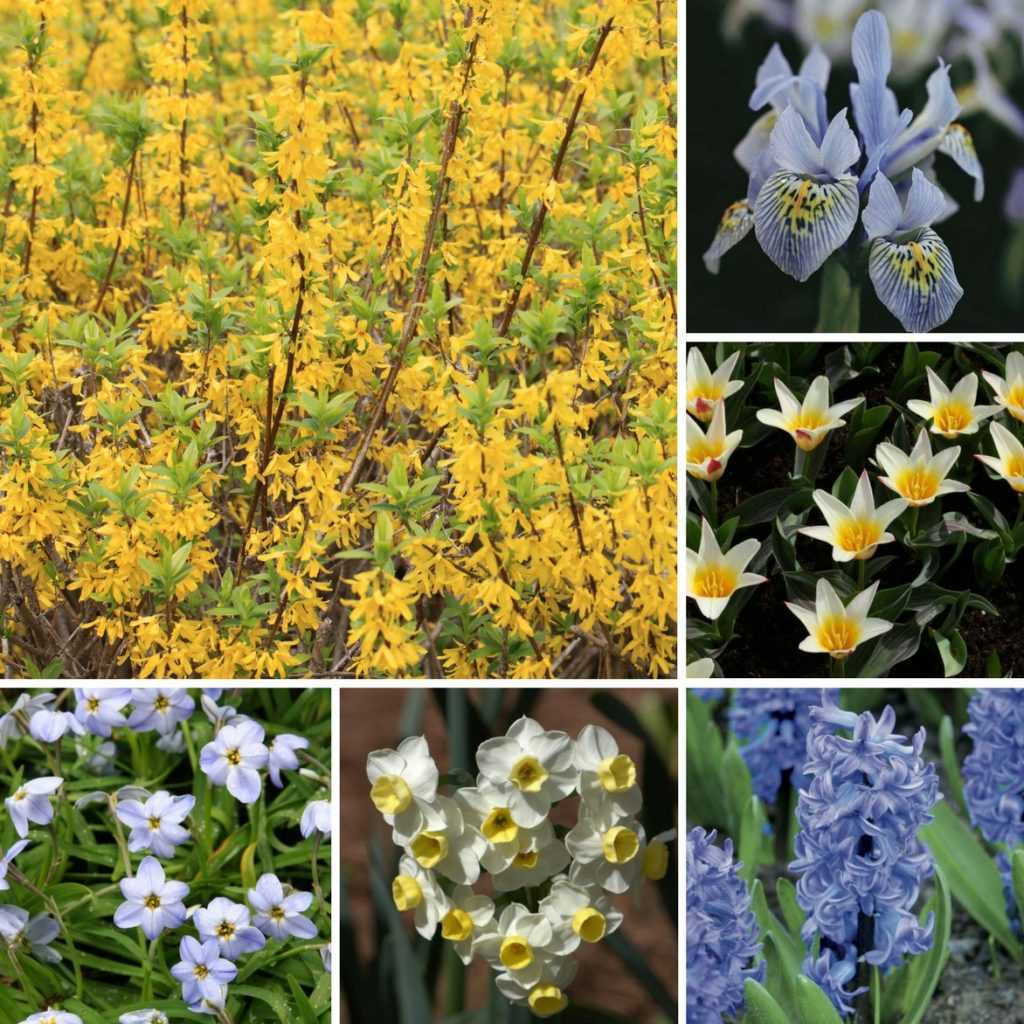
A golden yellow and blue association with forsythia Citrus Swizzle and, from top to bottom, Iris reticulata Kathrina Hodgkin, Kaufmanniana tulips Johann Strauss, Delft Blue hyacinth, New Baby daffodils, and Ipheion Rolf Fiedler.
Pair it with evergreen bushes to decorate the garden after the flowers have faded, such as Elaeagnus ebbingei Eleador with its magnificent variegated foliage or Mahonia Media ‘Charity’. the Delft Blue hyacinth, New Baby daffodils, and Ipheion Rolf Fiedler.
In low hedges or rockeries, Forsythia ‘Marée d’Or’ will shine alongside Cornus Canadensis, a tiny dwarf undershrub, or Kolkwitzia amabilis Maradco, also known as Beauty Bush due to the lovely bright yellow hue of its leaves.
Most Forsythias lose their appeal in summer unless they are draped with beautiful climbing plants that flower in summer, such as Lonicera.
Useful resources
- Discover our wide collection of Forsythias: you will find the most appreciated varieties as well as some rarities to explore!
- Find our tips on pruning forsythia
- Discover 7 bushes with yellow flowers
- Choosing a forsythia
- Our tutorial: How to force Forsythia branches for bright and colourful bouquets?
Frequently asked questions
-
Can you cut back a forsythia? If so, when?
Yes, forsythia tolerates pruning very well, even severely down to the ground, if you wish to reduce its spreading or reshape it. For a mature plant over three years old, cut back to the base, removing between 1/5 and 1/4 of the old stems to encourage the formation of young stems. Always prune after flowering. Only carry out such drastic pruning approximately every 8 years.
-
Does a red, pink, or white forsythia exist?
No, despite relentless research and the emergence and selection of new varieties, forsythias remain yellow-flowering bushes. However, there is a close cousin, Abeliophyllum distichum or Korean forsythia, which is available in white or pink. Although sharing the same name as forsythia, they are not of the same species. Like the latter, Abeliophyllum distichum flowers at the end of winter, on the previous year's branches and before the leaves appear. It is a beautiful alternative to yellow forsythia, adding a touch of white, pink, or red to your garden, balcony, or terrace.
-
What should I do if the leaves of my forsythia are brown?
Generally very resilient, Forsythia can, if grown in poorly drained soil, become vulnerable to fungal diseases. If the leaves of your bush turn brown, then black, eventually curling inwards, it is certainly affected by Phytophthora, a fungus that thrives in summer in heavy soils that retain water, heat, and humidity. Unfortunately, this will gradually weaken the bush until it is completely killed. There is no remedy; remove affected plants to prevent the disease from spreading to other vegetation. Be sure not to replant in the same spot. Forsythias grown in pots are more susceptible to this fungus.
-
My forsythia is completely dry, what is happening to it?
If the leaves turn grey, dry out, and then fall, your bush has probably suffered from heat stress and can still be saved. Forsythia prefers cool soils, not too dry. It has low water requirements, except during its first few years of planting and in extreme heat. In summer, during prolonged drought, water once or twice a week. To keep the base cool during the warm season, apply a good layer of organic mulch (straw, compost…).
- Subscribe!
- Contents































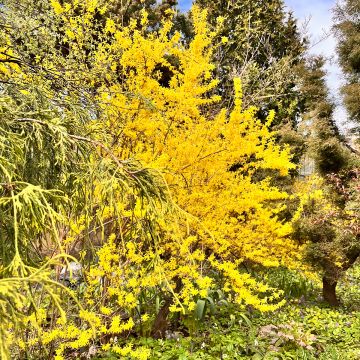



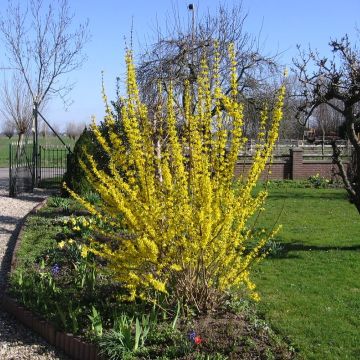
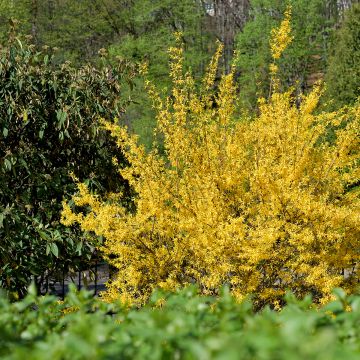
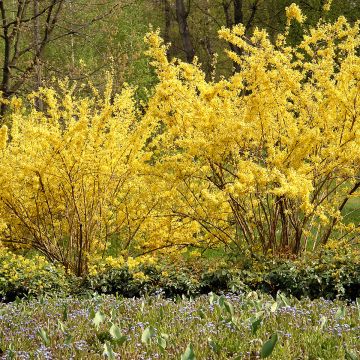
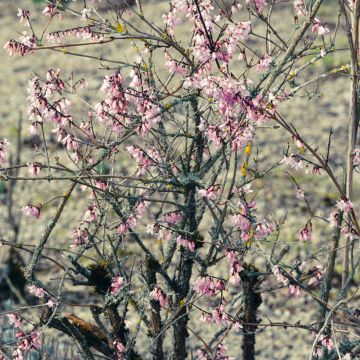

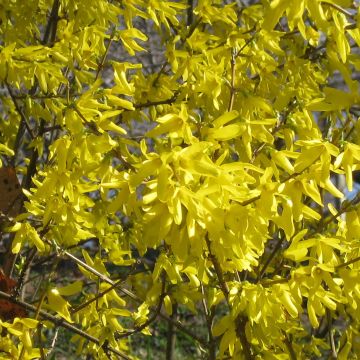
Comments